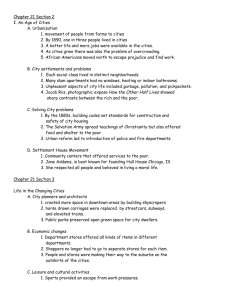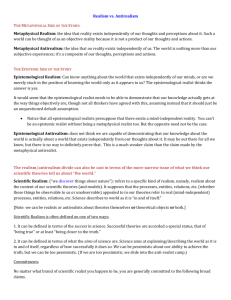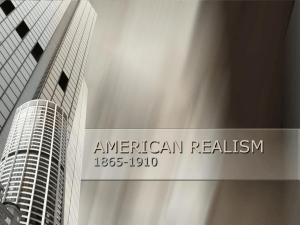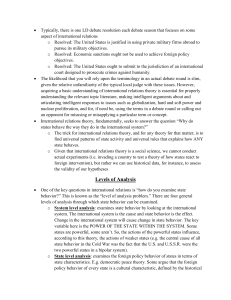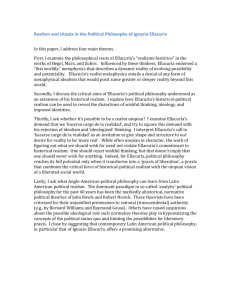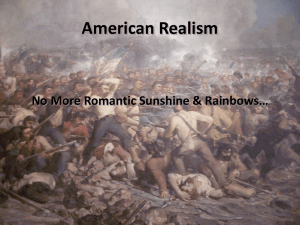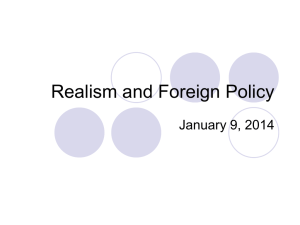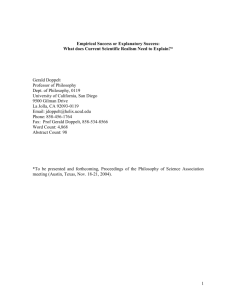April 19, 2011, Philosophy of Science Notes Chapter 14, The
advertisement
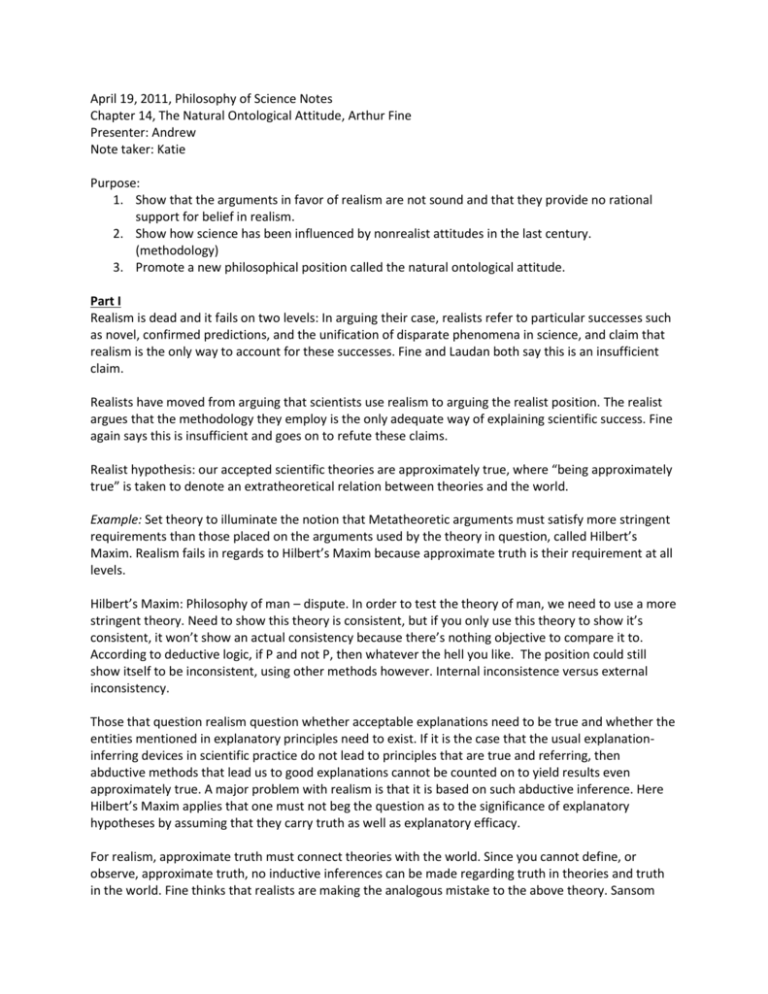
April 19, 2011, Philosophy of Science Notes Chapter 14, The Natural Ontological Attitude, Arthur Fine Presenter: Andrew Note taker: Katie Purpose: 1. Show that the arguments in favor of realism are not sound and that they provide no rational support for belief in realism. 2. Show how science has been influenced by nonrealist attitudes in the last century. (methodology) 3. Promote a new philosophical position called the natural ontological attitude. Part I Realism is dead and it fails on two levels: In arguing their case, realists refer to particular successes such as novel, confirmed predictions, and the unification of disparate phenomena in science, and claim that realism is the only way to account for these successes. Fine and Laudan both say this is an insufficient claim. Realists have moved from arguing that scientists use realism to arguing the realist position. The realist argues that the methodology they employ is the only adequate way of explaining scientific success. Fine again says this is insufficient and goes on to refute these claims. Realist hypothesis: our accepted scientific theories are approximately true, where “being approximately true” is taken to denote an extratheoretical relation between theories and the world. Example: Set theory to illuminate the notion that Metatheoretic arguments must satisfy more stringent requirements than those placed on the arguments used by the theory in question, called Hilbert’s Maxim. Realism fails in regards to Hilbert’s Maxim because approximate truth is their requirement at all levels. Hilbert’s Maxim: Philosophy of man – dispute. In order to test the theory of man, we need to use a more stringent theory. Need to show this theory is consistent, but if you only use this theory to show it’s consistent, it won’t show an actual consistency because there’s nothing objective to compare it to. According to deductive logic, if P and not P, then whatever the hell you like. The position could still show itself to be inconsistent, using other methods however. Internal inconsistence versus external inconsistency. Those that question realism question whether acceptable explanations need to be true and whether the entities mentioned in explanatory principles need to exist. If it is the case that the usual explanationinferring devices in scientific practice do not lead to principles that are true and referring, then abductive methods that lead us to good explanations cannot be counted on to yield results even approximately true. A major problem with realism is that it is based on such abductive inference. Here Hilbert’s Maxim applies that one must not beg the question as to the significance of explanatory hypotheses by assuming that they carry truth as well as explanatory efficacy. For realism, approximate truth must connect theories with the world. Since you cannot define, or observe, approximate truth, no inductive inferences can be made regarding truth in theories and truth in the world. Fine thinks that realists are making the analogous mistake to the above theory. Sansom suspicious of Fine’s argument: there might be other ways to actually do it, pretty dubious to try to learn something from the philosophy of man since no one really knows how to do it. Connection between realism and proof of set theory: realist likes to use arguments that competitors can’t use. Fine says realists might be able to find out if they are internally consistent or not and satisfy their own curiosity, but it won’t be meaningful in the real world. (if your argument proves too much, then it proves nothing) Arguments that realism is dead: Challenge the idea of approximate truth. Our accepted theories are approximately true, but for realism approximate theories must connect to the world. We can’t see approximate truth, so this fails. Fine says based on this, there can’t be realism. Small handful issue: The realist argument for why their methodology is the correct way to go about science. At any time in a given scientific area, only a small handful of alternative theories are in the field. Only such a small handful of theories are seriously considered as competitors, or as possible successors to some theory that requires revision. Moreover, this handful is very much related to that none deviates too far from the previously accepted theories in the field. This raises three questions: 1. Why only a small number of possible theories? 2. Why the conservative family resemblance between members of the handful? 3. Why does the strategy of narrowing the choices in this way work so well? Fine says realists have no answer to the first question, relies on the notion of approximate truth to answer the second and the third, which, according to the history of science has produced vastly more failures than successes. Alex says this makes sense and has no issue with Fine’s argument for the small handful of theories because the theory has to explain the phenomenon, and there are limited explanations that can actually work. There are only a certain number of players in an issue. Perhaps there is a bit of Putnam’s transtheoretical terms in here. On the other hand, the instrumentalist has answered the first and second questions quite well by pointing out that it is extremely difficult to come up with alternative theories that satisfy the many empirical constraints posed by the instrumental success of theories already in the field. Also, scientists are sculpted through apprenticeships in which their thoughts are channeled into commonly accepted categories and address theories in the way that “if it has worked well in the past, try it again.” How do we account for paradigm shifts? Are realists attached to the idea of approximate truth? Have theory, realist can explain why it’s successful in the real world because the theory approximately works in the real world. Instrumentalists say there is no real explanation; it just works because it works. Realism needs to take into account why most of the time science is wrong and be able to explain the occasional successes, claims Fine. History of science is the history of getting things wrong. Do realists need theories to be approximately true? For a realist, approximate truth has no notion of time because they have an objective view. If they do need theories to be true, then realism has only recently has become an adequate philosophy of science. It’s difficult to rest your entire philosophy on the idea that there won’t be total scientific revolutions. Realism should probably be more of the goal of science. Ross: realism as a coherence argument? Problems with approximate truth and conjunctions: Only realists can explain this, but Fine says this is not correct. If T and T’ are both true, then T + T’ should be true, too. Fine says that the approximate truth in these dissipates as you add them together, so this won’t necessarily work. Instrumentalists rule out the conflict because they’re not talking about approximate truth, they are taking the confirmed parts alone. Is this restrictive? Putnam doesn’t think an antirealist has the tools to do something like this. He says they don’t have the structure to explain truth. Fine says the opposite thing, that instrumentalists CAN put these two theories together while the realist can’t make the conjunction. Rule out “approximate” and use only proven parts of each theory. But how do you actually do this? Rule out the possibility of T and T’ being conflicting or mutually exclusive. Part II: Science as Nonrealism Fine explains how the two most prevalent physical theories, relativity and quantum theory, were brought about by people who held nonrealist philosophies Theory of Relativity came about by a nonrealist. Albert Einstein was a positivist in that he denied that the theory of relativity referred to any real world entity. Einstein shifted to realism later, but others think realism is an instrument but not a whole philosophy of science. Theoretical physicists are the least realist of all scientists, they are instrumentalists instead. Cartwright’s trade off may explain the difference between theoretical physics and the rest of science: explanatory power versus description. Realist wants to have both all the time, want “true description.” About Einstein’s conversion to realism: Einstein wanted to claim genuine reality for the central theoretical entities of the general theory. Fine says that if we granted Einstein this claim that space and time cease to be real. How is that? Successes in Science The founders of quantum theory also took an instrumentalist stance on their theory by saying that one should not try to form any picture of reality based on quantum theory. Also physicists who practice quantum theory do so in a highly nonrealist way and doing so has brought about a lot of predictive success in the history of science. We only have success in quantum mechanics from those who are nonrealists because they are unintuitive. Those physicists who are inspired by realist ambitions have produced no predictively successful physics. But, even those successful physicists who work according to nonrealist ideals all of a sudden become realists when they start to talk of their new discoveries. Looking at the history of science, we can conclude that realism isn’t necessary and sometimes impedes progress. Realism could be a hindrance of science if you can only choose from a small group of theories. Does realism restrict theory choice in a good way? This goes back to the small handful argument. Fine may think realism is committed to the small handful argument. Part III: NOA Fine trusts his own senses and the system of safeguards in scientific investigation, so that if a scientist tells him that there are electrons he will believe it to the same degree that he believes that a stove is hot. Moreover, if the instrumentalist says that electrons are a fictitious construct, then he would see no more reason to believe that the instrumentalist is a fictitious construct. He calls this the homely line, in which both realists and antirealists accept the results of scientific investigation as true, on par with more homely truths. The homely line is the core position of both the realist and the antirealist. Where they differ is in what they add to the core position. The antirealist: may add all types of things like a particular analysis on what is truth, or certain methodological strictures. The realist: adds only the quantifier REALLY! By saying that there really are electrons really! By doing so he denied the phenomenalistic reduction of concepts or the pragmatic conception of truth. The realist says that the truth of this theory corresponds to the world. What Fine proposes is that you take the natural ontological attitude by holding onto the core position and nothing else. Here, a statement being true means that it refers to an existing entity.

